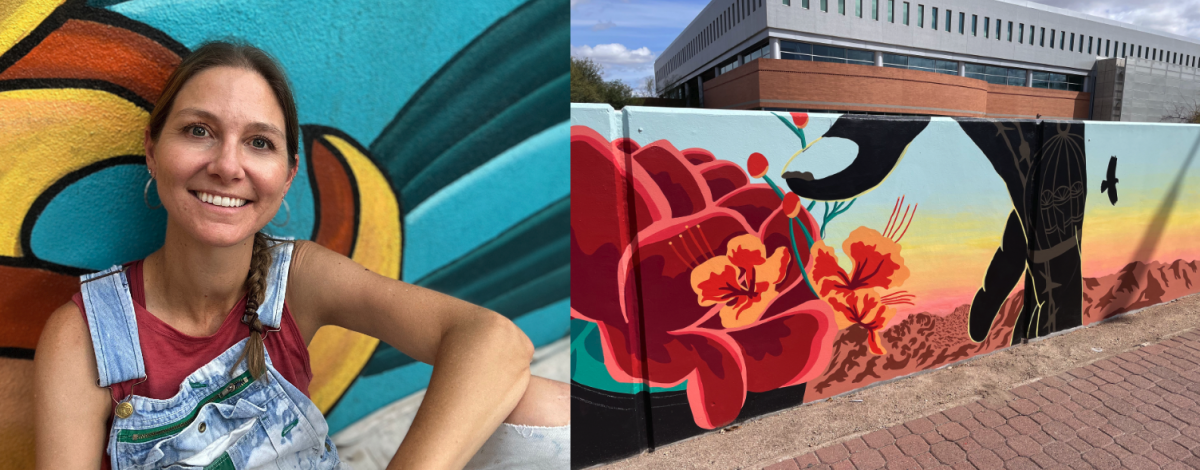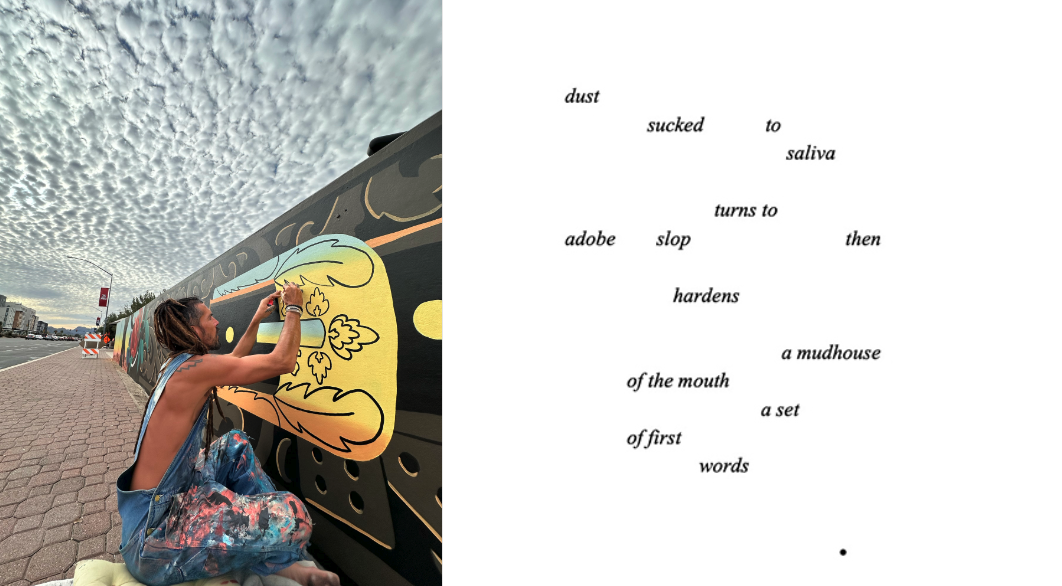In this series of interviews, Melissa Goodrich speaks to the artists who created poetry-inspired murals along the Speedway corridor. Today's interviewee is Jodie Lewers Chertudi.
It’s accessible to everyone—It’s a beautiful surprise
to find something unexpected painted on a concrete wall.
—Jodie Lewers Chertudi

reflecting the calloused beauty of growing up in a wild west tourist town through iconic imagery from Tombstone.
How long have you been an artist/muralist?
My first public mural was back in 2007 on 4th Avenue. Then I started my own graphic design business, got married and had kids so my next public mural wasn’t until 2022. I have dedicated much more to pursuing mural work time these last two years.
What led you to becoming a muralist? How would you describe your style, influences, or goals?
I’ve been practicing art ever since I was a little kid. My first love was black and white photography but ultimately chose a graphic design career path which led me to explore things like stencils, and mixed media collage art in my personal artistic practice. In college, Shepard Fairey came to speak to my VisCom class and I was hooked on his simple graphic style for creating street art and his style introduced me to other street arts like Bansky.
But before that, the first mural I really was ever conscious of was an orca mural by Robert Wyland at The Plunge in Mission Beach (1989). I was blown away by the scale and how realistic it looked. I was in awe of the magnitude of his murals and quickly started following his work.
My intent when I paint a mural is to make them larger than life so you can feel surrounded by their energy. I would describe my work as graphic and imaginary with bold colors.

Tell me about the poem that inspired your mural. How did you discover it? How did you take the words and transform them into images?
My dad had given me a brass belt buckle that belonged to my grandfather which had beautiful filigree with a real scorpion in the center and I thought that would be cool as a mural somewhere somehow. Then this project came up and the dimensions of the wall were so long and narrow I thought a western belt would be cool in that space.
As the Speedway project was evolving, Allison Miller presented an opportunity to work with the poetry center and sent us a collection of poems we could choose from.
The poem “Reckon” stuck out in my mind because it sounded like it might have a western touch to it and when I read the first few lines…“dust sucked to saliva turns to adobe slop then hardens a mud house…” I was like “sold!” because I grew up in Pinal County in an adobe house that my dad built, he even made the sun baked mud bricks.
Reading the entire poem, I was taken back by the artistry of his reflection of Tombstone and how he challenges everything the town stands for. I was overwhelmed with the incredible visual elements described in his poem and had a hard time narrowing down what I wanted to illustrate.
Side note: In high school, my dad worked on the movie Tombstone as a carpenter building set designs.
A world without art is so boring!
I know Logan Phillips, the poet who inspired your piece, stopped by as you were working—how did he respond to your mural?
He seemed taken back and grateful that I had selected his poem. Reckon is an excerpt from a larger manuscript he has been working to get published. He read a bit of the poem as we were painting with the intention of his words getting painted into the wall. He also signed his name and the name of the poem on the wall.

the rose is from the Tombstone Rose Tree Museum and ocotillo blossoms were near the OK corral.
Tell me about the mural itself: what you included, your process, and/or how you hope people respond to your work.
I did a lot of research and even went to Tombstone to take photos of things that the poet mentioned or things that inspired me to sketch. Some of the filigree on the belt is from the wall paper in Four Deuces Saloon, the rose is from the Tombstone Rose Tree Museum and ocotillo blossoms were near the OK corral.
The mural illustrates a simplified version of the poem of a woman in a “cyclical highnoon” stance with holsters filled with flowers that the poet compares himself to. I hope people go out and read the poem and come back to the mural with a new perspective.

What do you think public art like murals are important?
It’s accessible to everyone, you don’t need to pay to visit a museum or walk into an art gallery. It’s a beautiful surprise to find something unexpected painted on a concrete wall and even better if it challenges you to think about something in a different way. A world without art is so boring!
Why do you think poetry is important?
It’s another way for people to connect to an art form and allows them to use their own imagination. Like visual art, spoken words that can be interpreted uniquely depending on who is reading it. I deeply admire people who can take words and speak or write them into an art form.
______
Jodie Lewers Chertudi is native Tucsonan who daylights as a graphic designer, moonlights as a muralist and dreams in color. Growing up in rural Pinal County, she roamed the desert finding inspiration in the subtlest things nature had to offer, from silhouettes of an ocotillo against the Sonoran sunset to the sky's reflection in mud puddles after rain to shadows cast by the light from a full moon. She always fantasized about big city life and has a huge crush on graffiti art, surrealism, and abstract paintings. Jodie played basketball at Pima Community College and went on to graduate from Northern Arizona University with a degree in Visual Communication. She is the principal designer of JLewers Design and is never happier than when she is bringing an idea to life while rocking out to her eclectic music library.

